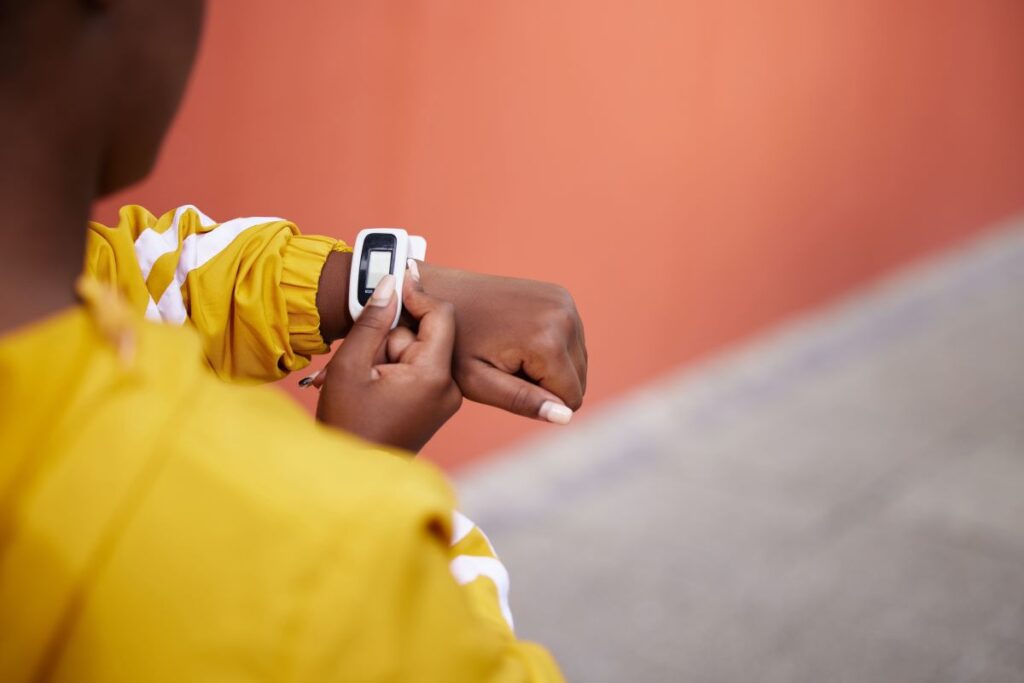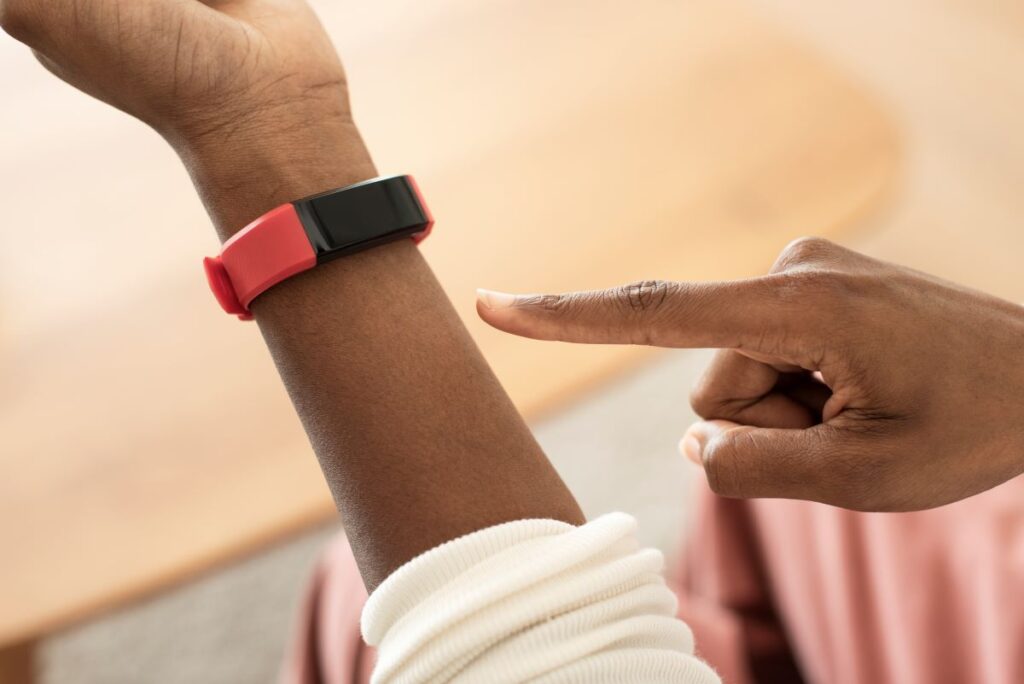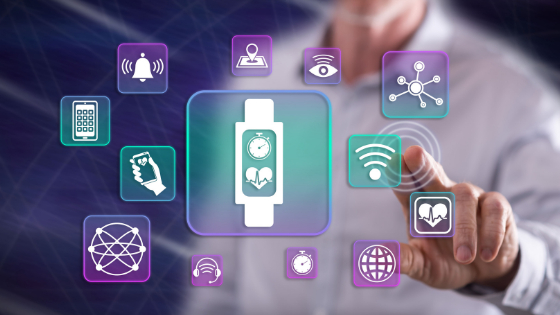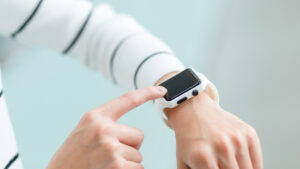Today is an opportune time to reflect on the major developments in the world of health wearables news throughout 2023. Building upon our recent exploration of the top 10 digital health news stories, where we highlighted the remarkable progress made in the field, we now turn our attention specifically to the realm of health wearables.
Just as we did last year when we published the Top 10 Health Wearables News in 2022, we invite you to join us on this journey as we revisit and celebrate the most significant advancements and breakthroughs in health wearables from the past year. From cutting-edge technologies to transformative applications, 2023 has been a year of innovation and discovery in the realm of health wearables, paving the way for a future defined by enhanced personal health management and improved well-being. So, let’s delve into the top 10 health wearables news stories of 2023, as we eagerly anticipate the exciting possibilities that lie ahead in this rapidly evolving field.
Here are our picks for the top 10 health wearables news:
Top 10 Health Wearables News in 2023

Challenges in Health Wearable Technology
This article explores the potential benefits of wearables in improving patient outcomes and driving advancements in personalized medicine while addressing the challenges that need to be overcome for successful implementation.
The article begins by acknowledging the positive impact of wearables on healthcare, such as continuous monitoring, remote patient monitoring, and personalized medicine. It emphasizes the potential of wearables to revolutionize preventive care, enhance treatment adherence, and empower individuals to actively manage their health. However, it also acknowledges the challenges that need to be addressed for wearables to reach their full potential.
One of the primary challenges discussed in the article is data privacy and security. Wearables collect sensitive health information, and ensuring secure data transmission, storage, and compliance with privacy regulations is crucial to maintain patient trust and confidentiality. The article emphasizes the importance of healthcare organizations and wearable manufacturers prioritizing data security and implementing robust privacy measures.
Another challenge highlighted is the accuracy and reliability of wearables’ readings. Although significant progress has been made in sensor technology, variations in readings can still occur. The article stresses the need for rigorous testing and validation of wearables to ensure precise and consistent data collection. Collaboration between manufacturers, healthcare professionals, and regulatory bodies is essential in establishing standards for accuracy and reliability.
The article also discusses the need for seamless integration of wearables with existing healthcare systems. Interoperability and data exchange frameworks should be established to allow wearables to communicate with electronic health records (EHRs) and other healthcare systems. This integration is crucial to maximize the utilization of wearables’ data in clinical decision-making and provide healthcare professionals with a holistic view of patients’ health status.
In conclusion, the article recognizes the potential of wearables in transforming healthcare but sheds light on the challenges that need to be addressed for successful implementation. Data privacy and security, accuracy and reliability of readings, and seamless integration with existing healthcare systems are key considerations. By overcoming these challenges, wearables can truly revolutionize healthcare delivery, improve patient outcomes, and pave the way for personalized and proactive healthcare.
Read more here

The Rise of Wearable Technology in the Healthcare Sector
The benefits of wearables in various healthcare domains and discusses considerations for effective implementation. The article begins by emphasizing that wearables have the potential to revolutionize healthcare by providing continuous, real-time data that empowers both patients and healthcare professionals. It discusses the significant role of wearables in enhancing cardiology care, particularly in the early detection of arrhythmias and assessing sleep-related disorders. Wearables also offer insights into physical activity levels, enabling physicians to tailor exercise prescriptions and promote overall cardiovascular health improvement.
Furthermore, the article highlights how wearables empower physicians with actionable data, especially through remote patient monitoring. It discusses examples of wearables assisting in managing chronic conditions such as diabetes, respiratory diseases, and promoting medication adherence. Remote monitoring through wearables enables healthcare professionals to track vital health metrics and intervene promptly when needed.
The article emphasizes the importance of addressing considerations for effective implementation. Data privacy and security are crucial concerns, and wearables should ensure secure data transmission and compliance with privacy regulations. Accuracy and reliability of wearables’ readings are also essential, and rigorous testing and validation should be conducted. The seamless integration of wearables with existing healthcare systems is important for effective utilization of data in clinical decision-making.
Lastly, the article discusses the future of wearables in healthcare. It highlights the integration of wearables with emerging technologies such as AI and machine learning, enabling personalized medicine and predictive analytics. It mentions how wearables combined with AI-powered virtual assistants can provide real-time monitoring and personalized health recommendations, revolutionizing preventive care.
In summary, the article explores the transformative impact of wearables in healthcare. It emphasizes their benefits in cardiology care, remote patient monitoring, and medication adherence. The article also highlights the importance of addressing considerations for implementation and discusses the potential for wearables to integrate with emerging technologies. Overall, wearables have the power to reshape healthcare delivery, improve patient outcomes, and enable personalized and proactive approaches to healthcare.
Read more here

Overcoming Critical Challenges in Wearable Technology
It emphasizes the need to address these challenges to ensure the successful integration and use of wearables in healthcare settings. The article first outlines the transformative impact of wearables in healthcare, including improving patient outcomes, enhancing remote patient monitoring, and enabling personalized medicine. It acknowledges that wearables have the potential to revolutionize healthcare by providing continuous, real-time data and empowering individuals to actively manage their health.
However, the article then delves into the challenges that need to be addressed for wearables to realize their full potential. One challenge highlighted is data privacy and security. With wearables collecting sensitive health information, it is crucial to ensure secure data transmission, storage, and compliance with privacy regulations. Healthcare organizations and wearable manufacturers must prioritize data protection to maintain patient trust.
Another challenge discussed is the accuracy and reliability of wearables’ readings. While significant progress has been made in sensor technology, variations in readings can still occur. Rigorous testing and validation are necessary to ensure precise and consistent data collection. Collaboration between wearables manufacturers, healthcare professionals, and regulatory bodies is crucial to establish standards for accuracy and reliability.
This health wearables news also emphasizes the importance of interoperability and seamless integration of wearables with existing healthcare systems. For wearables to be effectively utilized in clinical decision-making, they must be able to communicate with electronic health records (EHRs) and other healthcare systems. Establishing interoperable data exchange frameworks is necessary to enable wearables’ data to be integrated into the broader healthcare ecosystem.
Furthermore, the article highlights the significance of user acceptance and engagement. Wearables must be user-friendly, comfortable, and seamlessly integrate into individuals’ daily lives. Patients need to be motivated and empowered to actively use wearables for self-monitoring and make positive behavior changes.
In conclusion, the article emphasizes that while wearables have the potential to revolutionize healthcare, several challenges need to be addressed for their successful integration. Data privacy and security, accuracy and reliability of readings, interoperability, and user acceptance are key considerations for the effective implementation of wearables in healthcare. By addressing these challenges, wearables can truly transform healthcare delivery, improve patient outcomes, and drive advancements in personalized medicine.
Read more here

The Widespread Use of Wearable Technology Coincides With a Major Healthcare Advance
This health wearables news begins by emphasizing the growing popularity of wearables and their ability to collect real-time data on key health metrics. It discusses how wearables, such as smartwatches and fitness trackers, are enabling individuals to track their physical activity, heart rate, sleep patterns, and more. This continuous monitoring offers valuable insights into overall health and well-being.
The article then delves into the significant impact of wearables in cardiology care. It explains how these devices can detect and monitor irregular heart rhythms, such as arrhythmias, allowing for early intervention and potentially preventing severe complications. The article also highlights the role of wearables in assessing sleep-related disorders and promoting physical activity for cardiovascular health improvement.
Furthermore, the article highlights how wearables empower physicians with actionable data for more informed clinical decision-making. It discusses the benefits of remote patient monitoring in chronic disease management, citing examples such as continuous glucose monitoring for diabetes patients and monitoring respiratory conditions like asthma and COPD. Wearables improve medication adherence and provide personalized recommendations, leading to better disease management and patient outcomes.
The article emphasizes the importance of addressing considerations for effective implementation of wearables in healthcare. It stresses the need for strong data privacy and security measures to protect sensitive health information. The accuracy and reliability of wearables’ readings are also highlighted, calling for rigorous testing and collaboration between manufacturers, healthcare professionals, and regulatory bodies. Seamless integration of wearables with existing healthcare systems is deemed essential for maximizing their potential benefits.
In conclusion, the article emphasizes that wearables have the potential to reshape healthcare delivery by providing continuous monitoring, personalized insights, and empowering both patients and physicians with valuable data. By leveraging wearables’ capabilities and addressing implementation considerations, healthcare can be further improved, leading to better patient outcomes and advancements in personalized medicine.
Read more here

Exploring the Possibilities and Barriers of Wearable Technology in Healthcare
The article delves into the specific benefits of wearables in different healthcare domains. It highlights how wearables enhance cardiology care by enabling early detection of arrhythmias and providing insights into sleep-related disorders. It also discusses how wearables empower physicians with actionable data for remote patient monitoring and personalized disease management, particularly in chronic conditions like diabetes and respiratory disorders.
In addition to the benefits, the article acknowledges the considerations that need to be addressed for successful implementation of wearables in healthcare. It emphasizes the importance of data privacy and security, accuracy and reliability of wearables’ readings, and seamless integration with existing healthcare systems. These considerations are crucial to ensure patient trust, maintain data accuracy, and enable effective utilization of the collected data.
This health wearables news concludes by looking toward the future of wearables in healthcare. It highlights the integration of wearables with emerging technologies such as artificial intelligence (AI) and machine learning. The combination of wearables and AI holds immense promise for personalized medicine, predictive analytics, and real-time monitoring through AI-powered virtual assistants. The article also mentions the advancements in smart textiles, implantable sensors, and ingestible technologies, which provide opportunities for wearables to seamlessly integrate into individuals’ daily lives and enable deeper insights into health parameters.
In summary, the article explores the potential of wearable technology in healthcare. It discusses the benefits of wearables in cardiology care, remote patient monitoring, and personalized medicine. It emphasizes the considerations that need to be addressed for successful implementation and highlights the future possibilities of wearables in healthcare. Overall, wearables have the power to revolutionize healthcare delivery, improve patient outcomes, and enhance the overall quality of care.
Read more here

50 Digital Health Innovators: Celebrating the Digital Health and Wearables Series 2nd Anniversary!
We explore the advancements and key trends in the digital health and wearables space over the past two years. It highlights the transformative impact of these technologies on healthcare delivery and patient outcomes.
The article begins by acknowledging the rapid growth of wearables and their integration into healthcare ecosystems. It emphasizes the importance of wearables in empowering patients, improving patient engagement, and enabling remote monitoring. The ability of wearables to provide continuous, real-time data allows for more personalized and proactive healthcare interventions.
The article further delves into the specific areas where wearables have made significant contributions. It discusses the role of wearables in cardiology care, highlighting their ability to detect arrhythmias, monitor sleep patterns, and promote physical activity. It emphasizes the potential for wearables to detect cardiovascular issues early and prevent severe complications.
Additionally, the article explores how wearables empower physicians with actionable data. It discusses the use of wearables in remote patient monitoring for chronic diseases such as diabetes, hypertension, and respiratory conditions. The ability to track vital health metrics outside of traditional clinical settings enhances clinical decision-making and improves disease management.
The integration of wearables with emerging technologies such as artificial intelligence (AI) and machine learning is also a key focus of the article. It highlights the potential of AI algorithms to analyze wearable data and provide personalized insights and recommendations. This level of personalization enables more accurate diagnoses, treatment tailoring, and preventive care.
Moreover, the article mentions considerations for effective implementation of wearables in healthcare. It emphasizes the need for strong data privacy and security measures, accurate and reliable sensor technology, and seamless integration with existing healthcare systems. These considerations are crucial for ensuring the trust, accuracy, and effective utilization of wearable data in clinical decision-making.
In conclusion, the article highlights the significant advancements in digital health and wearables over the past two years. It emphasizes the transformative impact of wearables on improving patient outcomes, empowering patients, and enhancing physician decision-making. By providing continuous, real-time data and integrating with emerging technologies, wearables have the potential to revolutionize healthcare delivery and drive advancements in personalized medicine.
Read more here

7 Brands Redefining Wearables in Digital Health
I highlight seven brands that are pushing the boundaries of wearable technology to improve patient outcomes and enhance healthcare delivery. The first brand mentioned is BioIntelliSense, which has developed a wearable device called the BioSticker. This small, adhesive patch collects continuous vital signs data, including heart rate, respiratory rate, and temperature. The device is designed to monitor patients remotely, allowing for early detection of health issues and personalized care.
Next, Owlet is highlighted for its smart sock that monitors infants’ oxygen levels and heart rate while they sleep. This wearable provides peace of mind for parents by alerting them to any potential issues, such as irregularities in breathing or low oxygen levels.
Another brand, Embrace, focuses on epilepsy management with its smartwatch. The device detects seizures and sends alerts to caregivers, ensuring timely intervention and improved safety for individuals with epilepsy.
KardiaMobile, developed by AliveCor, is a portable EKG device that can be attached to a smartphone. This innovative wearable enables users to take medical-grade EKG readings anytime, anywhere, providing valuable insights into heart health and facilitating early detection of heart conditions.
This health wearables news also mentions Medtronic and its MiniMed insulin pump system. This wearable device continuously monitors glucose levels and delivers insulin as needed, enhancing diabetes management and improving patient quality of life.
Additionally, Quell by NeuroMetrix is a wearable device that targets chronic pain management. The device uses neurostimulation technology to alleviate pain by stimulating sensory nerves, providing a non-invasive alternative for individuals living with chronic pain.
Lastly, the article highlights Withings and its range of connected health devices. Withings offers a variety of wearables, including smart scales, blood pressure monitors, and sleep trackers. These devices integrate seamlessly with the company’s Health Mate app, providing a comprehensive view of an individual’s health data in one place.
In summary, the article showcases how these seven brands are redefining wearables in the realm of digital health. Their innovative devices address various healthcare needs, from remote patient monitoring and early detection to chronic disease management and pain relief. By pushing the boundaries of wearable technology, these brands are shaping the future of healthcare, empowering individuals to take control of their health and enabling healthcare professionals to deliver more personalized and effective care.
Read more here

5 Benefits of Medical Grade Wearables
These devices, specifically designed for medical use, offer numerous benefits that can improve patient care and outcomes. Firstly, medical-grade wearables provide accurate and reliable data. Unlike consumer-grade wearables, which may have limitations in terms of precision, medical-grade devices undergo rigorous testing and adhere to strict quality standards. This ensures that the data collected is highly accurate, providing healthcare professionals with reliable information for diagnosis and treatment.
Secondly, medical-grade wearables enable remote patient monitoring. With these devices, healthcare providers can remotely track patients’ vital signs, activity levels, and other relevant data. This allows for continuous monitoring and early detection of any changes or abnormalities, enhancing the ability to intervene promptly and prevent complications.
Another benefit is improved patient engagement and self-management. Medical-grade wearables offer features such as medication reminders, exercise tracking, and personalized health recommendations. These devices empower patients to take an active role in their healthcare by providing real-time feedback and guidance, leading to better adherence to treatment plans and healthier lifestyle choices.
In summary, medical-grade wearables offer significant benefits for healthcare practices. Their accuracy, remote monitoring capabilities, ability to improve patient engagement, support for personalized medicine, and facilitation of telehealth are key advantages. By incorporating these devices into healthcare settings, professionals can enhance patient care, optimize treatment outcomes, and improve the overall healthcare experience.
Read more here

5 New Health Wearables Transforming the Wellness Landscape
In recent years, the wellness landscape has been transformed by the emergence of new health wearables. These innovative devices are revolutionizing the way we monitor and manage our health, providing us with real-time data and personalized insights. In this article, we will explore five of these new health wearables that are reshaping the wellness industry.
- Smart Rings for Sleep and Stress Monitoring: Smart rings are wearable devices that can track sleep patterns and monitor stress levels. Equipped with sensors, these rings can provide detailed information on sleep quality, duration, and disturbances. By measuring heart rate variability and other physiological parameters, they also offer insights into stress levels throughout the day. This data empowers individuals to make lifestyle adjustments to improve their sleep and manage stress effectively.
- ECG-Enabled Smartwatches: Smartwatches with built-in electrocardiogram (ECG) capabilities have revolutionized cardiovascular health monitoring. These devices can record the electrical activity of the heart, providing valuable insights into heart rate irregularities and arrhythmias. Some smartwatches also offer the ability to detect atrial fibrillation, a common heart rhythm disorder. ECG-enabled smartwatches allow individuals to monitor their heart health conveniently and provide important data for healthcare professionals to make informed decisions.
- Continuous Glucose Monitoring (CGM) Systems: CGM systems have transformed the management of diabetes by offering continuous monitoring of glucose levels. These wearables, typically in the form of a small sensor placed under the skin, measure glucose levels in interstitial fluid. The data is then transmitted wirelessly to a receiver or smartphone app, allowing individuals with diabetes to track their glucose levels throughout the day. CGM systems provide valuable insights into trends and patterns, helping individuals make informed decisions about diet, exercise, and insulin dosing.
- Posture Correcting Wearables: Poor posture has become increasingly prevalent due to sedentary lifestyles and excessive screen time. Posture correcting wearables are now available to help individuals maintain proper posture and prevent musculoskeletal issues. These wearables can be worn discreetly as a small sensor or device on the body and provide gentle reminders or feedback when the wearer’s posture deviates from the ideal position. By promoting good posture habits, these wearables contribute to spinal health and overall well-being.
- UV Monitoring Devices: Sun exposure plays a significant role in skin health and the risk of developing conditions such as skin cancer. UV monitoring devices are wearable sensors that measure the wearer’s exposure to ultraviolet radiation. These wearables can track UV levels in real-time and provide alerts or reminders to apply sunscreen or seek shade when necessary. By raising awareness of UV exposure, these devices help individuals protect their skin and reduce the risk of sun-related health issues.
In conclusion, these five new health wearables are transforming the wellness landscape by providing individuals with valuable insights into their health metrics. From sleep and stress monitoring to cardiovascular health, glucose management, posture correction, and UV exposure tracking, these devices empower individuals to take proactive steps in managing their well-being. As technology continues to advance, we can expect even more innovative wearables to emerge, further revolutionizing the way we monitor and optimize our health.
Read more here

The Power of Wearables in Reshaping Healthcare Delivery
The last health wearables news on the list is about the relationship between wearables devices and healthcare delivery. One key area where wearables play a significant role is in cardiology care. By continuously monitoring heart rate and activity levels, wearables provide valuable insights into cardiovascular health. This allows for the early detection of arrhythmias and timely intervention to prevent complications.
Wearables are also enhancing remote patient monitoring for chronic diseases such as diabetes and respiratory conditions. For example, continuous glucose monitoring (CGM) systems offer real-time data on glucose levels, helping individuals manage their diabetes more effectively. Similarly, wearables can monitor breathing patterns and alert individuals and healthcare professionals to potential exacerbations in respiratory conditions.
Improved medication adherence is another benefit of wearables. These devices offer reminders and notifications to help individuals take their prescribed medications. This feature is especially helpful for complex medication regimens, leading to better disease management and patient outcomes.
In summary, wearables have the potential to revolutionize healthcare by providing continuous, real-time data and personalized insights. They enhance patient monitoring, empower physicians with actionable data, and promote personalized medicine. While challenges exist, addressing privacy, accuracy, and integration concerns will unlock the full potential of wearables in improving patient outcomes.
Read more here
Conclusion: Health Wearables News in 2023
The year 2023 has been a remarkable one in the realm of health wearables, with significant advancements and breakthroughs shaping the future of personal health management. As we reflect on the top 10 health wearables news stories of the past year, it is evident that cutting-edge technologies and transformative applications have paved the way for enhanced well-being.
Throughout 2023, we have witnessed the emergence of innovative wearables that enable continuous monitoring of vital signs, sleep patterns, and stress levels. These devices offer personalized insights, empowering individuals to take control of their health and make informed lifestyle choices.
In conclusion, the advancements and breakthroughs in health wearables news in 2023 have showcased the potential for transformative change in healthcare. By providing individuals with real-time data, personalized insights, and enhanced monitoring capabilities, wearables are reshaping the way we manage our health. As we eagerly anticipate what lies ahead, it is clear that health wearables will continue to play a vital role in improving personal health management and fostering a future of well-being.
Thank you for joining us on this journey through the latest in digital health and health wearables news. To stay in the know and explore further, here are some key links for you:
- Digital Salutem Website: Visit Digital Salutem for your weekly dose of digital health news and insights.
- Healthcare Uncomplicated on YouTube: Delve into the topics discussed in this article and more on our YouTube Channel, Healthcare Uncomplicated.
- Digital Salutem Podcast: Tune in to our thought-provoking discussions on the Digital Salutem Podcast. Uncover deeper insights into the world of healthcare transformation on Soundcloud and Spotify
- Share Your Thoughts: We value your feedback! Share your opinions on digital health, patient care, wearables, or anything, comment here or emailing us at info@digitalsalutem.com
- Connect with Us: For inquiries about Digital Healthcare Transformation, Healthcare organizational growth, or Healthcare brand positioning, reach out to us at +44 (0)1273 458590.
Your engagement fuels the ongoing dialogue shaping the future of healthcare. Let’s continue this transformative journey together!





